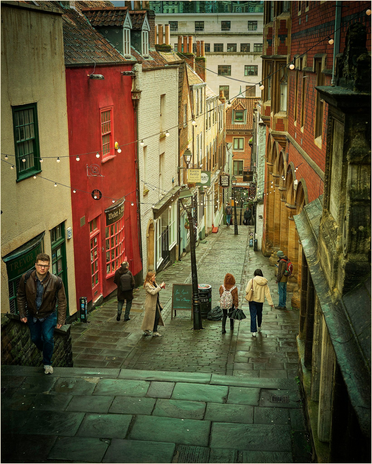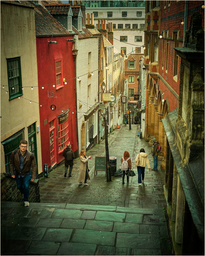History
The Christmas Steps remain an iconic and beloved image of Bristol. Dating all the way back to 1669, the stairs have seen many people come and go. From a place of battle during the Civil War to a busy shopping centre, they truly do hold their own small pocket of History. The area has undergone many changes over the years. However, in a constantly revolving city, the steps have remained intact. With the run up to Christmas and in time for the Holiday Season, Her Campus will explore the story behind these coveted steps.
The Christmas steps haven’t actually always been Steps. Before the steps were introduced the area was a steep and narrow alley. In fact, sources from the second half of the 17th century describe it as a, “precipitous footpath, very perilous to passengers.”
The stairs were first paid for by wealthy wine merchant, Jonathan Blackwell who later became sheriff of Bristol. The street was christened Queen’s Street, as named on Millerd’s map of 1673. This name was in place for around a century.
In the 17th century the name changed to Lonsford’s Stairs. They were given the nomenclature after a Cavalier Officer was killed at the top of the Steps during the English Civil War. Bristol was a major source of contention in the war against royalists and parliamentary forces. In fact, if you visit the steps, pay close attention to the statue of Madonna and child just inside the gates of Bartholomew Court. It is believed that Oliver Cromwell beheaded the statue himself. It is not clear if this is true or not, nevertheless it makes for a brilliant story. Outside Weber and Trings, a wine shop, you can see a plaque dedicated to Lunsford.
After the civil war, the Buildings on the Steps were occupied by Bristol Grammar school until 1767, as well as housing a variety of small shops. The School itself was forced to move in 1767 due the architecture being unsafe and not suitable for a boarding school. During Bristol’s era as a slave port Enslaved people are also noted as having been chained up along the steps.
Shopping
Following the relocation of the grammar school, both sides of the street were turned into shops, continuing to this day. Known for their flurry of independent and artisan businesses, the steps have been turned into a quaint shopping street. In the middle of the built-up city centre it is a haven of artisans, containing a theater, museum, pubs, cafes, and restaurants, as well as a brass instrument store and a stamp collector.
Popular Culture
The image of the Steps has been included in much modern popular culture. They feature heavily in the 1948 short film, The End of the Bridge, as well as in the 1998 song, Christmas Steps, by Scottish post-rock group Mogwai. Having listened to the song recently, for those a fan of instrumental music, it may be worth a listen. The stairs are also featured in Terry Pratchett’s 2012 book Dodger, inspired by Dickens’s the artful dodger. The Christmas Steps are described as the location of a pharmacist.
So why, you might ask, are they now known as the Christmas Steps? Some have placed the etymology in the nativity scene on the Chapel of the Three Kings of Cologne which stands at the top of the steps. Though a festive theory it can be safely discarded as the chapel was founded three centuries later than when the name was first used.
Others have traced its origins to them being named after Richard Christmas, a gossip and ‘old schoolfellow,’ of Blackwell. This theory is weakened due to the dates also not matching up. A far more widely accepted view is that they were named because of its proximity to Christmas Street, formerly known as Knyfesmith. Historians will need to dig further, however, to understand why the name Knifesmyth was changed to Christmas. Though perhaps not a particularly festive story, it is a colourful one nevertheless.
Today
Today, in the age of COVID-19 visiting the steps is a little haunting. Many of the shops lie empty or closed. However, there is hope that once able to re-open it will once again thrive. The steps are worth a visit even for a bit of escapism. The diagon alley-like architecture is completely unique to the rest of Bristol. In the true spirit of the name it is worth a visit this Christmas, either for some present shopping or to just soak in its wonderful history and culture.



